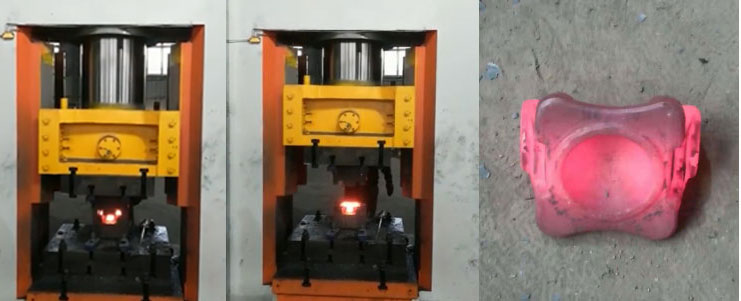Forging technology of flange fork of transmission shaft
Author: haloong Time: 2018-12-10 14:08:44
The flange fork of the transmission shaft is an important part of the automobile. It is the main part connecting the transmission and the drive axle and also the part bearing the complicated shape of high-speed transmission. Its structure and processing technology directly affect the performance of parts, and then affect the effect of the vehicle power transfer, the automobile transmission shaft flange fork is a more complex shape of parts, the traditional forging press hot pressing forming process and mold design mainly rely on the empirical method.
The forgings are complex in shape and can be divided into blank making, pre-forging and final forging. Because it has spherical surface and other shaped surface (non-machining surface) at the bottom, the former flange fork horizontal forging process cannot be used for forging, so the vertical forging process was established for this forging. However, the side part of the two ears of vertical forging process is of thin shape of high rib wall. In the process of press forging, the two ears are not easy to be filled, and it is difficult for forgings to be demoulded, which brings inconvenience to production. According to the research, only when the forging parting surface is raised upward in the design, the upper die ear groove is relatively shortened, which is conducive to filling both ears.
In addition, the drawing Angle of the outer surface of both ears should be appropriately increased to facilitate the demoulding of forgings (the inner side is a non-processed surface, and the drawing Angle cannot be increased). The contact area for forging die and forging, ear in some places because the product structure of the draft Angle is only 1 °. And forgings and lower die contact surface is relatively small, the mold draft Angle generally in more than 5 °. Therefore, in the production process of forgings will be bound to die, and die and no ejection mechanism, forgings can not ejection. Therefore, there is a ejection device using the lower die. But because the forgings do not stick to the lower die, for this reason, groove was added on the outer plane of the lower die ears, that is, the forgings formed a negative draft gradient here. If the groove is too deep, it will affect the appearance quality of forgings, and it is easy to damage the mold; if it is too shallow, it will not work, so that forgings are forced to stick down the mold, and then use the ejector device to push out the workpiece.

A customer drive shaft flange fork production site
Fork flange forging process is mainly: the installation on the forging press the slider on the flange of the fork mold under the effect of forging press downward momentum, the flange fork of workbench is installed in the forging press mold placed on the round billet heating under pressure, when the closed on mould and lower mould is blank flange fork with larger flash, then through cutting die get blank flange fork after trimming.
Although the structure of the flange fork of the transmission shaft is relatively simple, but the processing technology is complex, so in the material selection, reasonable arrangement of the processing process, the design of reasonable fixture, determine the reasonable molding process. So as to ensure the final quality of products.







